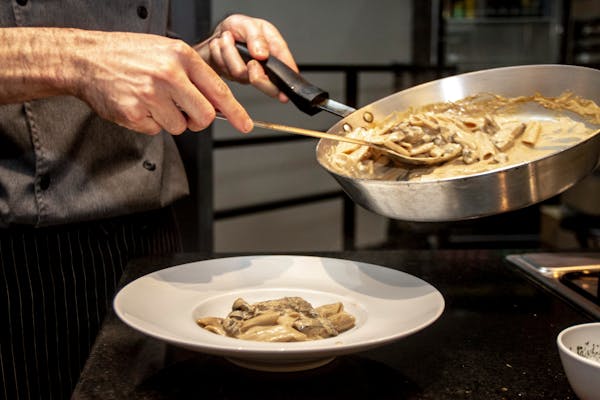Tonari brings wafu Italian cooking to DC straight from Japan
[ad_1]
Wafu cuisine is very well regarded in Japan, but not so properly known outside of the nation. Tonari desires to transform that.
WASHINGTON — Tonari, the newest restaurant from the Daikaya Team, is on a mission. But its mission did not start off wherever you may anticipate.
The people powering Daikaya own various ramen retailers distribute out across the District, including its namesake ramen shop (with Izakaya upstairs) Bantam King fried chicken and ramen, Hatoba and Haikan.
Tonari is proper following door to Daikaya, and all around the corner from Bantam King. But for the group’s upcoming act, they did not want to open up another ramen shop.
To hear Daikaya co-operator Daisuke Utagawa reveal it, when they walked into the house that would become Tonari, they realized what they had to do.
The concept for Tonari is wafu Italian cuisine.
“The word wafu means Japanese-design and style,” Daisuke stated. “Normally it implies a little something that is not at first Japanese that is completed in Japanese style.”
Daisuke suggests Tonari’s wafu Italian is not a new type of cuisine, but it is some thing that is new to D.C., and new to the United States.
“Wafu Italian is not anything we invented,” Daisuke claimed. “It is a thing that exists in Japan, but it’s not perfectly-acknowledged outside of Japan.”
Daisuke stresses that wafu Italian is a coming-collectively of cultures, rather than what some may well call “fusion.”
“I individually really do not like the phrase fusion,” he mentioned. “Not because of what it usually means, but due to the fact of what the connotations are. There is a variation in between a natural cultural phenomenon of two matters meeting and getting to be something, nearly organically, as opposed to one thing that is put alongside one another by drive.”
Which is the mission at the rear of Tonari: To teach people about the thought of wafu Italian delicacies. To present the heritage of two cuisines that came together obviously over the program of decades in Japan.
Wafu pasta dates back to the ‘50s with a restaurant whose identify translates to “hole in the wall.” Daisuke explained the purpose that the use of Japanese components in Italian cooking took off in Japan is that the two cultures share a similar method to cuisine.
So why provide that model of cooking to D.C. diners?
“Here’s a basic answer for you,” Daisuke states, gesturing to a enormous black pizza more than at the middle of the kitchen. “That oven.”
It was clear to the Tonari team that they needed to use that big oven in some regard. That’s the place the idea of wafu pizza and pasta was born. But even though wafu pasta experienced roots and background at the rear of it, wafu pizza was something solely new, and one thing that Daisuke and his associate dove into headfirst.
Having by now established a ramen provider in Sapporo, Japan as a result of their other ventures, that provider explained to them they also make pasta, and that they tasted various from any other pasta they could get for the reason that of how they are made.
“They have this ramen technologies and they utilized it to pasta, and it is a thoroughly various point,” Daisuke mentioned.
Pizza was much more operate. Because there was no recognized wafu pizza, they had to start off from the ground up.
“If we want to make wafu pizza, we have to outline it,” Daisuke stated.
That sent Daisuke and his Daikaya companion Chef Katsuya Fukushima to Japan to create a dough utilizing inspiration from Japanese milk bread – what Daisuke phone calls Japanified Wonderbread.
“We went through iteration and iteration and iteration and what we arrived up with was like, ‘Oh my god, this is truly neat,” Daisuke stated.
He reported the total system took about 3 months, via tons of back again-and-forth and trial-and-mistake. They worked on everything from the components of the dough to the cooking vessel, to the temperature and timing prior to they settled on the dough.
What finishes up on your plate at Tonari is a thing that seems like your ordinary deep dish pizza, but preferences fully various. It’s crispy and crunchy, though staying chewy and pillowy at the identical time. It is immensely craveable.
What pushed Daisuke and his spouse to establish this new pizza? The quick response is the oven, but it goes further than that.
“There’s a lot of means to seem at a cafe. A single is, you are hungry, you’re feeding people today. But you can do that anywhere,” Daisuke reported. “But when you are going to a cafe, you obtained to have an added motive to go there. At the conclusion of the day it is a group, suitable? When you are making a community you have to have ethos. The ethos to us is fairly important. We’re in this each and every working day. If we just do it due to the fact ‘Yeah, it’s a business enterprise,’ you kind of drop enthusiasm.”
That enthusiasm was examined when Tonari 1st opened its doorways in 2020. Months later on the COVID-19 pandemic strike and the restaurant had to pivot, briefly offering acquire-away solutions, shutting down and inevitably presenting a tasting menu when doors opened once again.
Now, Tonari is back to full toughness, they have nixed the tasting menu and offer things a la carte. They were being also just additional to the 2022 version of the D.C. Michelin Tutorial. From wherever Daisuke is standing, the accolades are not what this cafe is about. The target is not to get a Michelin star.
Related: Additional than a dozen DC dining establishments additional to Michelin Guide
Associated: What is actually in a star? This is what it will take to get just one of cooking’s greatest honors
“Our target is not to be a Michelin-star cafe,” he claimed. “Our purpose is to get the phrase out on what folks are having in Japan now.”
That generate to get the term out is anything shared by Nico Cezar, Chef de Cuisine at Tonari. Chef Nico is an alum of Michelin star Italian cafe Masseria so he’s putting his qualifications to fantastic use.
“It’s a blessing for me to be capable to parallel my instruction beneath cooking Japanese food and cooking Italian foodstuff, which can make [wafu cooking] a little easier to technique due to the fact I know that I can use this component, or that approach,”Cezar claimed. “It’s easier for me to method it that way than sticking to basic Italian or vintage Japanese. What we want to do is make sure that we are obeying this lifestyle of meals in Japan and introducing it to the world… Earning them knowledgeable that there is these a point as Japanese-type Italian food items. We’re not trying to mash up items for the sake of fusing two cultures collectively, you want to make positive that it is paying out homage to that culture-certain food design.”
When cooking the spaghetti napolitan, a dish which is been on the menu since Tonari opened, the chef points out the worth of the noodles and the fresh elements utilized to convey the uncomplicated dish jointly.
“I consider it surprises folks anytime they flavor the dish, they are like, ‘Oh it is a ketchup spaghetti, how good could it be?’ It’s just how it is place jointly,” Cezar said. “Buying item which is at the peak of its year. The most effective of what you can responsibly get. Something that’s sustainable. Which is anything that I want to thrust ahead to the menus that we have here, just generating certain that we’re sticking to the identical notion of representing Italian cooking and Japanese cooking… generating confident that we’re paying respects in a respectable way with no trying to reinvent the wheel. At the end of the working day I want Japanese men and women to arrive in right here and be like ‘Oh, this continue to would make sense. This restaurant is undertaking every preparing or system justice and representing it very well.’”
The menu, which Cezar would like to transform just about every month, attributes some pizza and pasta mixtures that may possibly be challenging to some diners, but Cezar hopes that all those who appear to Tonari will be adventurous, and prepared to consider a little something new. For instance, the Mentaiko product is a sauce built with cod roe. Ideal now, it’s featured on equally a pasta and a pizza on the menu.
As he loads a Mentaiko and corn pizza into the all-critical pizza oven, he explains that the pie receives loaded with cheese, and that the cheese aids the pizza get ridiculously crispy in the pan.
“It’s virtually like a corner of a lasagna, but everyone gets a corner piece,” he said.
Cezar suggests establishing new menu objects and recipes can be tough, but it’s anything he enjoys.
“The elegance about discovering Japanese-style cooking is you benefit subtraction as you go,” the chef explained. “You only use what you require, and that is really really hard for a chef to do.”
He mentioned it goes again to the mission of getting the term out about wafu cuisine.
“How do you teach people is the hard element,” Cezar mentioned. “If you blindfold somebody they’ll think, ‘this is a pepperoni pizza.’ Yeah, but do you flavor the intricacies of the substances that go into the sauce? That’s the obstacle. I think we have finished a good position. My hope is that, moving ahead, we’ll have a lot a lot more men and women curious to appear and say, ‘I want to see what you guys are carrying out.'”

Checking out Tonari
707 6th Street Northwest
Monday & Tuesday – shut
Wednesday & Thursday – 5 pm to 9:30 pm
Friday and Saturday – 5 pm – 10 pm
Sunday – 5 pm – 9 pm
WUSA9 is now on Roku and Amazon Hearth TVs. Download the apps now for stay newscasts and video on demand from customers.
Down load the WUSA9 application to get breaking information, weather conditions and important tales at your fingertips.
Signal up for the Get Up DC newsletter: Your forecast. Your commute. Your news.
Indicator up for the Capitol Breach electronic mail publication, delivering the hottest breaking information and a roundup of the investigation into the Capitol Riots on January 6, 2021.
[ad_2]
Supply backlink







